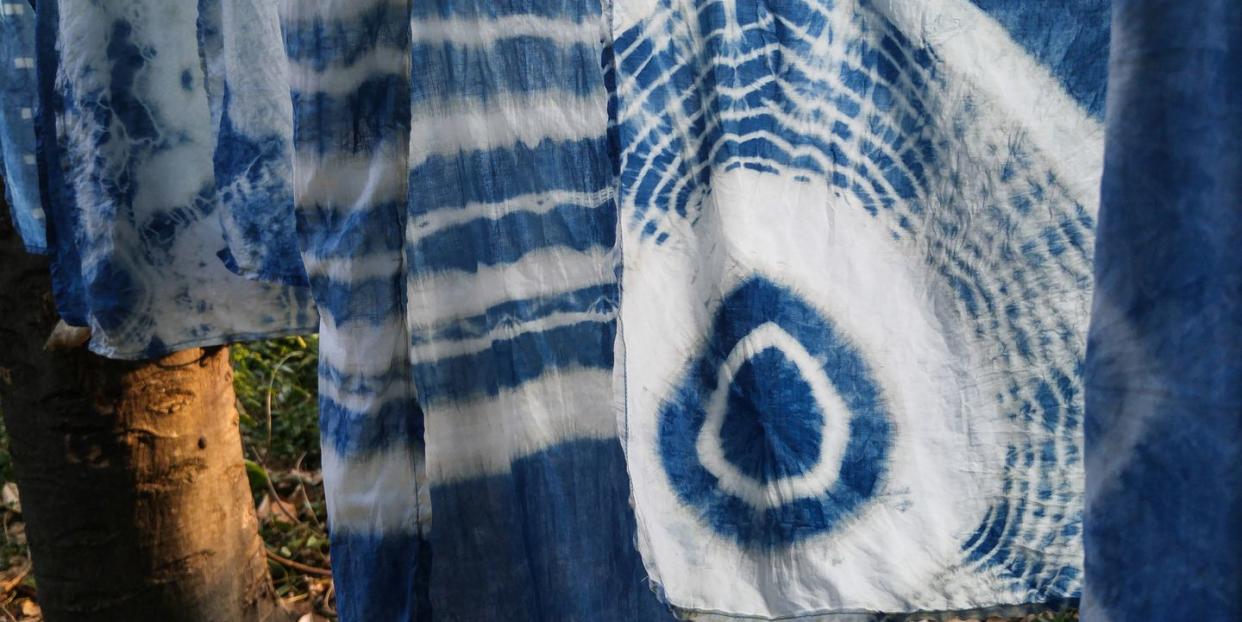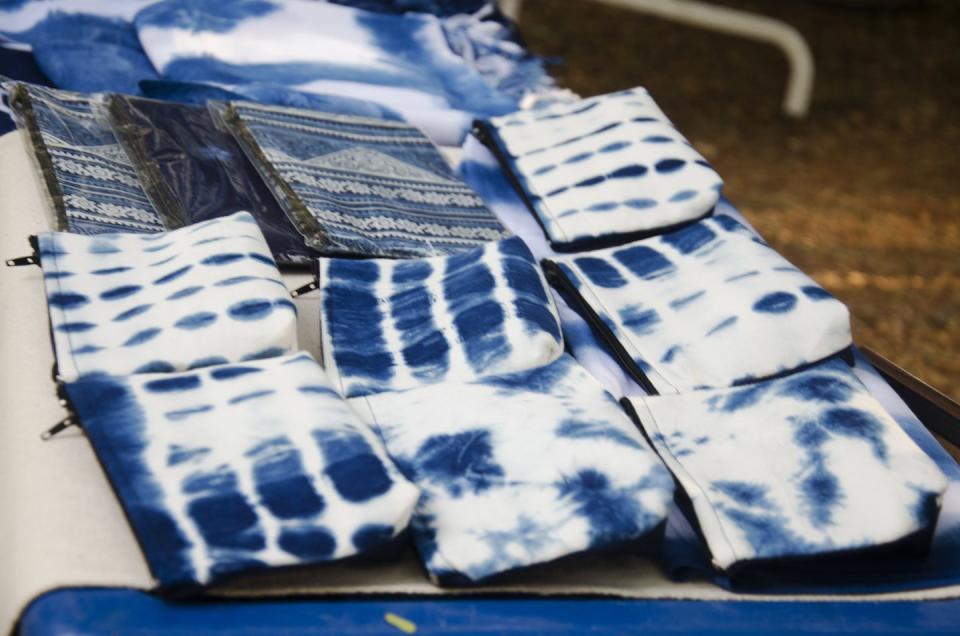Everything you need to know about shibori

If you're looking for a new crafty challenge or a way to express your creativity, shibori is definitely worth exploring.
Shibori is a way to create unique patterns and designs on fabric using resist dyeing. These stunning deep indigo patterned fabrics can then be turned into a whole range of projects from clothing and cushion covers to upholstery and curtains.
With its rich history, intricate techniques, and endless possibilities, shibori is sure to spark some inspiration.
Read on to discover what shibori is, how you can try it and the best kits for beginners to buy.
What is shibori?
Shibori is a Japanese term for a range of traditional resist-dyeing techniques that have been used for centuries to create beautiful and intricate patterns on fabric. The word "shibori" comes from the Japanese verb "shiboru", which means to wring, squeeze, or press.
Shibori involves manipulating fabric in various ways before dyeing it, using techniques such as folding, twisting, binding, and stitching. The fabric is then immersed in a dye bath, and the areas that have been bound resist the dye, creating unique patterns and designs.
Shibori is a fascinating and versatile art form that allows you to experiment with different techniques and materials to create your own unique designs. It's a great way to add a personal touch to your clothes, accessories, or home decor, and it's also a fun and relaxing activity that can help you unwind and de-stress.
A brief history of shibori
Shibori has a long and rich history that dates back to ancient times, with evidence of the technique being used in China, India, and Japan as early as the 8th century.
Shibori evolved into a highly refined art form in Japan, where it was used to create beautiful and intricate designs on kimonos and other textiles.
Shibori was also used in other cultures, such as Africa and South America, where it was known as tie-dye or bandhani. It continues to be a beloved art form that is practised around the world, and its unique patterns and designs are celebrated for their beauty and cultural significance.

Beautiful shibori techniques
Shibori involves a variety of techniques to create unique patterns and designs on fabric. Here are some of the most common shibori techniques:
Kanoko shibori: This technique is similar to tie-dye and involves tying small pinches on the fabric with thread or elastic bands to create your pattern. It creates a more organic pattern and can be used all over your fabric or just in a small section.
Miura shibori: This technique involves pleating the fabric and then binding it with string to create your pattern. You fold the fabric back and forth to make accordion pleats and then bind the pleats tightly with string to create your pattern.
Nui shibori: This technique is also known as ‘stitching shibori’ and involves stitching the fabric with a needle and thread in any design you like to create a resist pattern. You start by drawing out your design (using a washable fabric pen is best) on your fabric and then stitch along the line with thread. Once your row of stitches is done, you pull the thread tight so that the fabric bunches or cinches up around it. Those parts that are pulled together tight will resist the dye and make your pattern.
Arashi shibori: This technique is also known as ‘pole-wrapping’ and involves wrapping your fabric tightly around a pole, binding it with string to compress sections and hold it in place and then pressing your fabric together from both ends so that it scrunches up around the sting to make pleats. The end result should be a striped chevron design.
Kumo shibori: This technique is sometimes referred to as ‘spiderweb shibori’ and is similar to Kanoko Shibori but gives a bigger and more intricate pattern. You pinch and gather the fabric in small sections and then bind them with string or elastic bands. Then you pull more of the fabric up and bind further down the same piece to create a larger pattern.
Itajime shibori: This technique, also known as ‘clamp-resist shibori’, involves folding the fabric into accordion or fan pleats and then clamping it between two flat objects to create an area that the dye can’t get to. You can use something as simple as large wooden lolly sticks or wooden dowels, but you can also get special acrylic shapes online, especially for creating unique Itajime designs.
What you need
Fabric/clothing. You need to use a natural fabric such as cotton or silk that can easily absorb the indigo dye.
Shibori indigo dye. You can get authentic indigo dye or use a synthetic dye in indigo or a deep blue colour to get the same effect.
Rubber bands/twine/string
Needle and thread. If you are doing Nui shibori
Wooden blocks or shapes. If you are doing Itajime shibori
2 tubs or buckets. One for your dye and one to rinse your fabric in
Rubber gloves and a drop cloth/plastic mat. To protect your hands and any work surfaces from getting stained.
Fun shibori projects to try
There are so many ways to incorporate shibori style dyeing into your craft projects, here are some of our favourite simple shibori craft ideas.
Tea towel
Tea towels are a great project to try out a range of different Shibori techniques with.
Since they are relatively small pieces of fabric, you can get some tight folds and binds on them without them getting too bulky.
Plus you can never go wrong with a DIY to make a practical item such as a tea towel, they are a great way to change up your kitchen colour scheme or even to give as gifts.
Hair tie
How cute are these bow hair ties! To make your own, start by dyeing a piece of cotton fabric with your chosen shibori technique. Once your fabric is dyed, rinsed and dried; iron it flat and cut it into rectangular stripes.
Taking one rectangle of fabric, fold it in half and sew along the 3 open edges (leaving a small gap in one end for turning).
Turn the rectangle right side out and press flat, use a small running stitch to close the seam. Get a plain hairband and tie your shibori fabric in a bow to make your hair tie.
You could also use your shibori dyed fabric to make a custom hair scrunchie!
Cushions
If you're looking for a fun way to change up your home decor, why not try making some shibori design cushion covers like these ones from Diamond Foam and Fabric on Instagram. You can find a range of plain cotton cushion covers ready to dye online in pretty much any size you could ever need.
If you want to experiment with geometric patterns, try the Itajime shibori technique.
Tote bag
Creating custom design cotton tote bags is another great low cost and practical project to try. Why not try using the Nui shibori technique to stitch line designs of fruit and vegetables into your fabric before dyeing.
Scarf
The great thing about using shibori to personalise clothing is that the traditional deep indigo colour goes with so much! Using it to make a stylish looking wrap scarf is an ideal way to make a versatile accessory to go with any outfit.
Patchwork
Tried out lots of shibori techniques and left with a pile of interesting designs? Why not make them into a patchwork quilt, like Nerida on Instagram. If you want to go a step further with the design you could add hand stitched quilting that follows the shibori pattern to certain patches.
Shibori kits to try
Craft kits are a great way to out a new project without having to invest too much into a ton of supplies. Here are some of the best Shibori kits available online:
Frequently asked questions about shibori
What is the difference between tie dye and shibori?
Shibori is essentially the original version of our modern tie dye. The only real difference is that modern tie dye uses a whole range of coloured dyes whereas shibori uses just indigo.
What is the best material for shibori?
Shibori works best on natural fabrics such as cotton, hemp or silk as they absorb dye quickly and evenly.
Why is shibori dye blue?
Traditional shibori dye is made from the indigo plant which produces a vibrant and deep indigo blue colour. If you want to try the traditional way of creating indigo dye there are kits available to buy online, alternatively lots of dye brands create vibrant indigo shades of dye that will give the same effect.
Do you love crafting? Share your creations with us by tagging @primamag in your pictures on Instagram!
You Might Also Like


